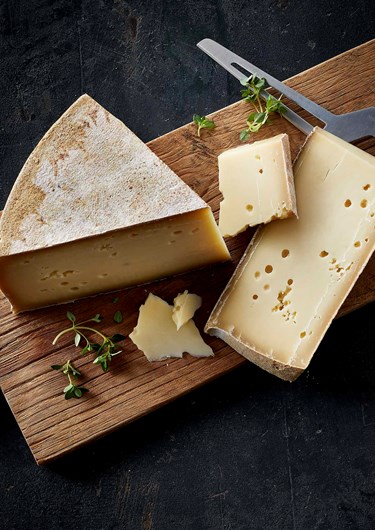
Fontina Cheese
What is Fontina?
At the feet of the Alps, in the Italian Aosta valley, lie the lush meadows upon which red-pied Valdostana cows provide the milk needed to produce Fontina. Incredibly rich and creamy, the flavors of this cheese are sweet and pungent, unveiling tones of butter and roasted nuts as it lingers on your palate. Traditionally made from unpasteurized milk, the texture is semi-hard, smooth and adorned with small holes in the body.
Surrounding the grasslands of the Aosta valley, caves and crevices in the mountains provide the perfect low temperatures for aging, giving Fontina its dense and open interior. The cheese absorbs the naturally filtered moisture from the caverns, providing the distinct aromas and nuances unique to Fontina.
Not just limited to Italy, Danish and Swedish versions of Fontina are characterized by their waxed rinds and sweet savory flavor.
How Fontina is made
To produce a perfect wheel of Fontina, artisans rely on their expertise and skill to work in symbioses with the mountains of Valle d'Aosta.
Milk is delivered directly from the pasture to the creamery, where large copper cauldrons are filled and heated. Enzymes and calf rennet are added to promote coagulation of the milk, resulting in the formation of curd. When firm, it is then separated and drained through a cheesecloth, before being placed in wheel-shaped molds. After it has brined for two months, the wheel is ready for aging in the caverns of Valle d'Aosta. A process of pure artisanship, workers tend to the cheeses by turning, brushing and salting them every other day. After three months maturing in the humid grottos, the cheese is officially labelled Fontina.
In most cases, no artificial preservatives of any kind go into producing Fontina, and it is gluten free. Most versions of Fontina are made without additives, making them suitable for those who are gluten intolerant. Still, labels should always be double-checked
Substitutes for Fontina
Look for other semi-hard cheeses that emulate the rich taste of Fontina when looking for a cheese to use in its place.
Related by nationality, Provolone is another semi-hard cheese mainly produced in the polders of northern Italy. Normally mild in taste, this cheese melts easily thanks to its firm and slightly grainy texture.
For use in fondue, Gruyère produces a rich and creamy sauce similar to that of Fontina. Sharp and with a touch of hazelnut and butter, this cheese sits well with a wide variety of different meats and vegetables.
Curious about the world of cheese? Here's everything you need to know about how to store, serve and cut cheese!







